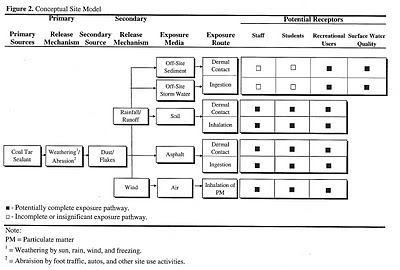Some might say this is a bold statement coming from a non-toxicologist. Well let’s do some old fashioned “connect-a-dot” with what we know and see if you might agree.
Potent Mutagen
We showed previously that CTS are a potent mutagen, right out of the bucket. Just How Toxic is CTS?
Uncle Sam Says So on Soils Near CTS
First there is general agreement among scientists that children are the most susceptible part of our population to environmental contaminants.
For years it was hoped that the federal government toxicologists would just look at the safety of children exposed to coal tar sealants. A few years ago I discovered that they already have, but it was coincidental. A school district outside of Austin, Texas (Leander) was looking to build a new elementary school. They purchased a property that met their needs except that it had been a chemical research facility. When parents found out, many were very upset. So upset that they got the attention of their elected officials, who in turn brought in the feds (more specifically the Agency for Toxic Substances and Disease Registry ATSDR, who routinely does this kind of work)).
They tested the soil and analyzed the risks. They found high levels of polycyclic aromatic hydrocarbons (PAHs) in the soil near where there were parking lots and the source was determined to be coal tar pavement sealants. The levels were sufficient to increase cancer risk in a low to moderate range if it remained at the proposed site. As a result soils were removed under the description of “remediaton.” Link to School Study
Higher Levels (& Risks) Are Commonplace on Pavement
The USGS in their study of indoor dust revealed that it was common to find the concentration of PAHs 10 times higher than what was found at the Leander School site (Link to USGS Study). So what is the effect of these levels? At minimum they would have a moderate cancer risk increase.
Independent Toxicologists Agree with Exposure
In 2009 the Austin Independent School District began to look into this issue at their schools. Below is a link to an interview that was made just as the study was getting started. Since then their toxicologist consultant found that there exist 5 complete CTS exposure pathways from paved surface to child or adult! An exposure pathway is defined by the ATSDR as follows:
The route a substance takes from its source (where it began) to its end point (where it ends), and how people can come into contact with (or get exposed to) it. An exposure pathway has five parts: a source of contamination (such as an abandoned business); an environmental media and transport mechanism (such as movement through groundwater); a point of exposure (such as a private well); a route of exposure (eating, drinking, breathing, or touching), and a receptor population (people potentially or actually exposed). When all five parts are present, the exposure pathway is termed a completed exposure pathway.
 |
| Complete Exposure Pathways at Schools from Coal Tar Sealants |
So according to a professional toxicologist all five parts are in play at our schools. A link to this study is here: Toxicologist Findings About CTS at Schools. Video Interview Concerning CTS at Austin Public Schools The second half of their study, which presumably will have concentrations, risk assessment, and remediation recommendations has not yet been released.
Use on School Facilities Throughout US
It would be reasonable to assume that if coal tar sealant use is frequent in a community then it would be used at the community’s schools. That has been my observation in communities across the country. The US Department of Education tallies the number of elementary and secondary schools in the US is just under 100,000 facilities. While in some cities it has been as high as 50% of the schools use CTS (Austin, Half of AISD Schools Have Coal Tar Contaminated Lots, Oak Hill Gazette), the national average may be between 10% to 25%. This would be at least 10,000 schools with CTS on their lots or playgrounds!
The Dots
So here’s what we know:
- CTS is a mutagen
- CTS increases cancer risk at schools
- Toxicologists find 5 complete exposure pathways at schools
- Higher levels are expected than those that have been studied
- There are more than 10,000 schools nationwide that may have this on their paved surfaces
EPA’s Recommended Action
While the EPA has not directly addressed CTS at schools, here’s what the EPA is saying about keeping toxins out of schools:
However, irrespective of these guidelines, EPA does recommend that districts periodically inspect existing schools for potential environmental health and safety risks using tools designed for that purpose such as EPA’s Healthy School Environments Assessment Tool (HealthySEAT) or the NIOSH Safety Checklist Program for Schools. Where deficiencies are found, steps to reduce student and staff exposure to potential hazards should be identified and implemented, to the maximum extent practical.
According to the guidelines, toxic material use (like coal tar sealants) in a playground area is a deficiency. Therefore effort should be made to correct these potential hazards. We’d better get busy, there is a lot of work to be done. Maybe we could start by eliminating the use of this product at our schools.

